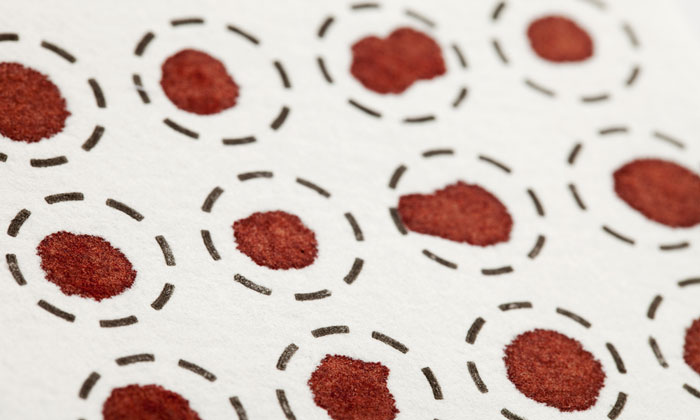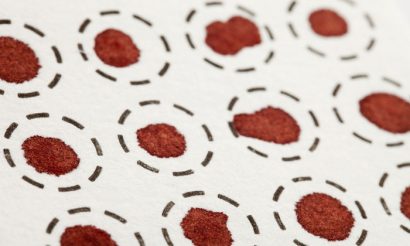Better, cheaper healthcare with dry blood samples
Posted: 24 May 2017 | | No comments yet
In a new study, Uppsala University researchers have successfully measured 92 different proteins in millimetre-sized circles punched out of dried samples…


A drop of blood on filter paper, allowed to dry and stored for future diagnostic purposes – considerably easier than the present-day, resource-consuming method using frozen blood samples in plastic tubes.

In a new study, Uppsala University researchers have successfully measured 92 different proteins in millimetre-sized circles punched out of dried samples. They have shown that this method has great potential to save resources, to the benefit of early diagnostics and treatment.
Stored blood samples are of utmost importance for finding disease markers that can be used for early detection of diseases, when they are still curable. Today, test tubes holding relatively large volumes (millilitres) of blood plasma are kept in big, energy-guzzling freezers at −80°C. A patient must first go to a healthcare unit where a trained nurse obtains a venous blood sample, which is sent to a lab for centrifugal separation of plasma. The sample can then be analysed and/or saved in a biobank for future studies. This resource-consuming method means, for example, that Uppsala University Hospital currently saves only 1% of all samples in a biobank, while the rest are discarded after an initial analysis.
The new method could change this situation radically and have a crucial value for development of future healthcare. The study shows that very little happens to proteins when they are allowed to dry.
In many cases, they remain completely unaltered after 30 years, or change only minimally. Consequently, dried samples could be used for health services’ routine checks. These could be performed in the fast-growing laboratory service sector, enabling people to have their state of health investigated without engaging medical and health services. The samples could also be used to set up very large-scale biobanks. Costs in the healthcare sector would plunge, more samples could be analysed and a high proportion of all blood samples taken could be saved.
“This has several implications. First, you can prick your own finger and send in a dried blood spot by post. Second, at a minimal cost, it will be possible to build gigantic biobanks of samples obtained on a routine clinical basis. This means that samples can be taken before the clinical debut of a disease, to identify markers of value for early diagnosis, improving the scope for curative treatment,” says Ulf Landegren, Professor of Molecular Medicine and head of the Molecular Tools research group.
Study specifics
In the present study, the scientists analysed dried blood spots (DBS). Some had been collected recently, while others had been preserved for up to 30 years in biobanks in Sweden and Denmark that store DBS samples taken from all newborn babies for screening of some 20 congenital metabolic disorders. These two biobanks keep their DBS at different temperatures: the Swedish one at +4°C and the Danish one at −24°C. The samples were used to analyse levels of 92 proteins that are relevant in oncology. Wet plasma samples, kept at −70°C for corresponding periods of time, were also used. In addition, in order to be able to distinguish the effects of the long-term storage, the researchers examined what happens to protein detection as an effect of the drying process.
“Our conclusion is that we can measure levels of 92 proteins with very high precision and sensitivity using PEA technology in the tiny, punched-out discs from a dried blood spot. The actual drying process has a negligible effect on the various proteins and the effect is reproducible, which means that it can be included in the calculation,” says Johan Björkesten, a doctoral student at Uppsala University and the first author of the study.
Further development and method
Interest in using biobanks to search for proteins or RNA molecules that can dynamically reflect disease progression is growing rapidly. Sample collections comprising many samples taken regularly from the same individuals are very important for identifying biomarkers of this type. This has two advantages.
First, over time, individuals can serve as their own controls. Second, after a person has fallen ill, the many samples taken improve the scope for locating patient samples taken before the onset of the disease, in a phase in which early diagnosis can be particularly valuable. One precondition for this is the availability of large numbers of samples, collected regularly from many individuals. This makes it essential for costs of individual samples to be low and the entire process, from sampling to storage, to be very simple and preferably require no healthcare staff to be involved.
The use of DBS affords a range of advantages over using “wet” samples. Examples are minimal stress for patients since a tiny, self-administered prick on the finger suffices; costs of collection and storage are low; no highly trained staff are required for the sampling; samples can be sent by letter post; and storage conditions are simple. One of the major limitations of dried samples, on the other hand, has been the small quantity of blood taken, which rules out many traditional analytical methods.
Long-term DBS storage affects the detectability of certain proteins more than others. Most proteins remain completely intact after 30 years, or change only minimally, while measured levels of some proteins decrease so that half the quantity remains after a period of between 10 and 50 years. The researchers have also found that a relative low storage temperature is preferable for proteins that are affected by storage. Compared with storing wet plasma at −70°C, they found that this preserved the proteins better than DBS storage at −24°C. This part of the analysis was, however, complicated by some confounding factors that made the conclusion less clearcut.
The proximity extension assay (PEA) method allows detection of levels of 96 proteins (including 4 controls) from a disc 1.2 mm in diameter punched out of a dried blood spot (DBS) on filter paper. PEA, based on research at Uppsala University, has been developed into a commercial product, Proseek Multiplex, by the Uppsala company Olink. To date, the company has used the method to analyse a quarter of a million wet plasma samples.




